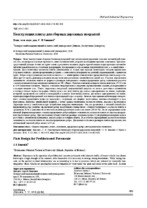| dc.contributor.author | Зиневич, С. И. | |
| dc.coverage.spatial | Минск | ru |
| dc.date.accessioned | 2019-01-02T08:45:00Z | |
| dc.date.available | 2019-01-02T08:45:00Z | |
| dc.date.issued | 2018 | |
| dc.identifier.citation | Зиневич, С. И. Конструкция плиты для сборных дорожных покрытий = Plate Design for Prefabricated Pavements / С. И. Зиневич // Наука и техника. – 2018. – №6. – С. 465-470. | ru |
| dc.identifier.uri | https://rep.bntu.by/handle/data/48408 | |
| dc.description.abstract | Опыт эксплуатации сборных бетонных покрытий при интенсивном движении тяжелых автомобилей показал, что, несмотря на высокую прочность самих бетонных плит, под них необходимы прочные основания. При непоредственной укладке бетона на грунт в нем в результате нажимов упруго прогибающихся при проходах автомобилей плит накапливаются остаточные деформации, что приводит к образованию под плитой пустот, а в самой плите – трещин. Для увеличения жесткости плиты (уменьшения ее осадок при проезде транспорта) автором предложено устраивать плиты с двумя продольными ребрами, а сами плиты укладывать на рыхлый, перемешанный с цементом грунт. Ребра следует размещать на полосах наката, т. е. симметрично относительно продольной оси плиты, на расстоянии друг от друга, равном расстоянию между колесами расчетного автомобиля на одной оси. С целью определения зависимости жесткости плиты от формы и размеров поперечного сечения продольных ребер выполнены расчеты с использованием метода конечных элементов на ПК «Лира». Конечно-элементная модель плиты включала 19152 узла и 18943 конечных элемента. Упругое основание моделировалось упругими вертикальными связями, находившимися в каждом нижнем узле. Плита загружалась нагрузкой, эквивалентной нагрузке от колеса расчетного автомобиля в четырех точках: колесо посредине плиты; колесо на углу плиты; два колеса одновременно на линии, перпендикулярной продольной оси плиты и находящейся в начале (или конце) плиты; два колеса одновременно на линии, перпендикулярной продольной оси плиты и проходящей через ее центр. Вначале при одинаковой площади поперечного сечения продольного ребра исследовались следующие его формы: треугольная, овальная (полукруг) и прямоугольная. Наиболее оптимальной формой, с точки зрения увеличения жесткости плиты, оказалась треугольная. Перепады высот у такой плиты при воздействии нагрузки наименьшие. Так, по сравнению с типовой плитой (без продольных ребер) наличие продольных ребер треугольного поперечного сечения увеличивает жесткость плиты в среднем на 50 % в зависимости от места положения расчетного колеса на плите (39–64 %). После определения оптимальной формы поперечного сечения продольного ребра найдена зависимость жесткости плиты от высоты продольных треугольных ребер. При постоянных объеме плиты и размере основания ребра 32 см (примерная ширина колеса расчетного автомобиля) изменялись высота ребра и толщина плиты. В результате проведенных расчетов получена зависимость жесткости плиты от высоты продольного ребра. Для данного объема и размеров плиты определено, что оптимальной высотой ребра является 25 см. | ru |
| dc.language.iso | ru | ru |
| dc.publisher | БНТУ | ru |
| dc.title | Конструкция плиты для сборных дорожных покрытий | ru |
| dc.title.alternative | Plate Design for Prefabricated Pavements | ru |
| dc.type | Article | ru |
| dc.identifier.doi | 10.21122/2227-1031-2018-17-6-465-470 | |
| local.description.annotation | Experience in the operation of prefabricated concrete pavements with intensive traffic of heavy vehicles has shown that despite a high strength of the concrete slabs themselves it is necessary to arrange strong foundations. While laying concrete on the ground residual deformations are accumulating in it due to pressures which are initiated by elastically bending plates when vehicles are passing that leads to formation of voids under the plate and cracks in the plate itself. In order to increase rigidity of the plate (reduction of its settlement during the passage of vehicles) the author has proposed to arrange plates with two longitudinal ribs, and the plates themselves are to be laid on loose soil mixed with cement. The ribs are proposed to be placed on roll bars, i. e. symmetrically with respect to a longitudinal axis of the plate at a distance from each other which is equal to the distance between wheels of the calculated vehicle on one axis. In order to determine dependence of plate rigidity on a shape and a size of a cross section in longitudinal ribs calculations have been made while using a PC “Lira” and a finite element method. A finite element model of the plate has included 19152 nodes and 18943 finite elements. An elastic foundation has been modeled by vertical elastic links which are in every bottom node. The plate has been loaded with a load which is equivalent to the load from a calculated vehicle wheel at four points: a wheel in the middle of the plate; a wheel on the corner of the plate; two wheels at the same time on the line which is perpendicular to the longitudinal axis of the plate and located at the beginning (or end) of the plate; two wheels at the same time on the line which is perpendicular to the longitudinal axis of the plate and passing through its center. The following forms of a longitudinal rib having the same cross- sectional area have been studied at the beginning: triangular, oval (semicircle) and rectangular. In the context of plate rigidity increase the most optimal form has been a triangular shape. Height differences in such a plate are the least in case of load action. So, for example, in comparison with a typical plate (plate without longitudinal ribs), presence of longitudinal ribs of triangular cross– section increases plate rigidity by an average of 50 % depending on the location of the calculated wheel on the plate (39–64 %). After determining an optimal shape of cross section for longitudinal ribs the dependence has been found for plate rigidity and it depends on a height of longitudinal triangular ribs. While having a constant volume of the plate and a constant a size of the rib base (32 cm) (approximate width of a calculated vehicle wheel) a rib height and a plate thickness have been changed. The calculations have made it possible to determine dependence of the plate rigidity on a height of a longitudinal rib. It has been determined that as for the given volume and dimensions of the plate the optimal rib height is 25 cm. | ru |

